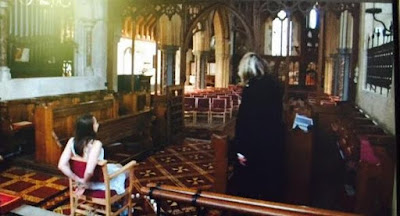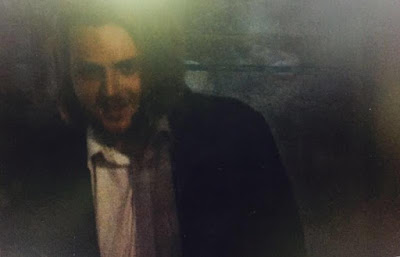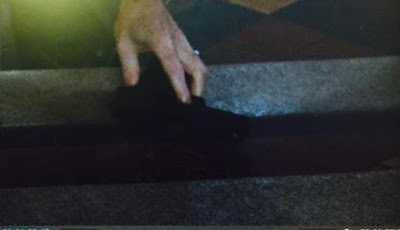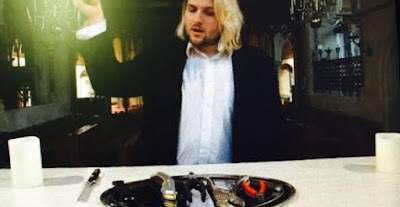Below is the script that we used for our Mise-En-Scene video:
Hello everybody, today I am going to be talking to you about my monthly mise-en-scene favourites. This is the month of November and so these ideas would all be great for Halloween season which works well with the thriller film idea. This month there have been a lot of things that I have really enjoyed using from costumes, to locations and even props. This months theme was thriller films and so i have really been trying to capture the encaptivating and mysterious look that comes with a thriller film.
One of the things I have really been enjoying this month is costumes. One of the looks I have been really enjoying is the hostage victim look because you can really capture the vulnerability and innocence of this type of character through a white dress which provides connotations of youth, purity and naiveity.
This look works best with a short white dress because the colour white shows the connotations of innocence and vulnerability. The fact that you are wearing white definitely provides denotations that you are a victim and this works well with the genre and conventions of a thriller film.
This look, achieved with a white dress provides a sense danger to come and the fact that the particular dress I chose to wear had lace on it added to the vulnerability and innocent youthfulness created with this look. The adhering stereotype of the victim in white works really well for this look.
However, the issue with wearing this look during the winter months is that you will be really cold and so it is important to accessorise the look appropriately, with a matching jacket or a shawl. It is important that you also consider wearing tights to keep your legs warm.
Another look in terms of costumes that I have really been enjoying wearing this month is the psychopath look, however this look works better on males. You can achieve this look through a white smart shirt, black suit trousers, smart black shoes and a black winter coat. This look, at first glance appears to be a subverting stereotype because someone with a crazed mind is wearing such smart clothes, which would usually be a representation of a business man. This look can be made to look like a psychopath through minor details such as a non-ironed shirt which is crumbled up and shoes which have mud on them and have been scuffed up.
This costume provides connotations of someone who is going to do a business deal, however in this circumstance it is someone who is dealing with a negotiation over a hostage.
The problem with this costume is that it can sometimes be mistaken for a different type of character as it is a subverting stereotype. It can appear too smart on camera, and sometimes a more casual and scruffed up costume would work more effectively at providing sufficient connotations for the character of a psychopath.
The final look that I am going to be showing you today is an inspector/negotiator. This look can be achieved through a smart suit, a fedora style hat and a black trench coat. This provides an adhering stereotype, as the smart and business like style of this costume connotates that an inspector is work driven and conscientious.
The use of the dark colours of the suit and a boring tie gives a slightly dated look to this character's costume and it also provides connotations of a uniform look to the costume. The colour connotations behind the dark colours of the suit suggest that the inspector is harsh, has high authority and also that they are used to dealing with the bad guys, such as the psychopath mentioned earlier.
The problem with this costume is that the dark colours could provide connotations that the inspector is the villain, which would be an incorrect representation of an inspector. Another thing which could cause problems, is the use of the dated suit could connotate and generalise that all inspectors are old fashioned and have dated opinions and methods of negotiating.
Another area of mise-en-scene I have been enjoying recently is props, as these can add to a character's costume to make them more dynamic and add more character detail as well as provide genre connotations.
One of the particular props that I have been enjoying recently is a retractable knife. I prefer retractable knives because they add to the connotations of danger and suspense, whilst also being a very safe prop to use as they cause no harm to the actors using them. It is important to ensure that a retractable knife looks realistic on camera, as if it looks tacky and fake this could affect the mise-en-scene. Knives are a suitable prop for a thriller film because they provide an adhering stereotype of danger, violence and death. The issue with using the props of knives is that you have to ensure that they look realistic on camera, however when in public, they cannot be mistaken for real knives and really they should not be used in the public because of the assumption that they are real. Another disadvantage of using a knife prop is that they will not cause any harm to the actor and that the material will not hurt the actor.
Another prop that provides great mise-en-scene in a thriller film is torture weapons to be used on a victim. This is an adhering stereotype as torture weapons provide connotations of harm, danger, violence as well as creating suspense and atmosphere. However, when using the prop of a torture weapon, as with a knife prop, you have to be careful when in public that they are not mistaken for being real and not a prop, also you need to ensure that they do not cause harm to the actor and that they are safe to use.
A prop that I find works really well for a torture victim or hostage and would work well with the white dress are duct tape and rope, these can be used for muting the victim and tying up their wrists or ankles. These props provide adhering stereotypes as they are usually associated with torture and hostage situations. The connotations behind these props are that they are being used to make the victim vulnerable and not giving them the freedom to talk or escape the torture. However, the problem with using these props is that sometimes they can cause harm, and so you have to be very careful not to tie the rope too tight around the victims wrists and ankles. A good tip for when using duct tape is to put masking tape on the other side and stick the masking tape to your face which makes it appear like the duct tape is stuck to the face, this reduces the pain when the tape is ripped off.
The final prop that I have been enjoying this month is candles. Candles are a really effective prop as not only do they provide a source of light, but they also have the connotation of relaxing, religion and peacefulness, which is a subverting stereotype as this completely juxtaposes the use of the torture weapons, tape, knife and rope. The flickering of the candle light mirrors the emotions being felt by the torture victim and the metaphor behind blowing out the candles is that another victim has been tortured and the lighting of the match symbolises the start of another torture session. I really like the hidden meaning and the symbols behind the prop of a candle as they can be used in two completely different ways to connotate different meanings. However, the limitation of using a candle is that they can effect the continuity of the scene if you use real candles because the wax levels will lower, and the limitation of using the battery operated candles is that they run out of battery very quickly and often they look very unrealistic.
The next area of mise-en-scene that I have been enjoying this month is Location and Setting. The location that I am going to be talking to you about is a Church. A Church can provide a range of connotations due to the fact that it can either been seen as a religious and holy place of worship or a mysterious, creepy, haunted building with good acoustics and atmospheric lighting.
I decided to use a Church because I believe it provides connotations of mystery, paranormal or spiritual beings, religion, the presence of a greater being as well as a creepy, suspenseful and haunting atmosphere.
I believe that by using such a location it really enabled us to show the audience through the location, the feelings and emotions of the victim as well as the psychopath as the creepiness and haunting qualities could be seen and almost mirrored in the psychopath, whereas the purity, tranquility and holiness could be seen in the calmness of the negotiator/inspector and the innocence of the victim.
However, the issue with using a church as a location is that it is a place of worship and so some of the elements of a thriller film need to be checked and possibly adapted as to not be offensive to the church. Another problem with filming in a church is that most of the things within a church are actually from the 14th century therefore, they have a lot of sentimental value as well as being impossible to replace, therefore it is important to be very careful when filming inside this location.
Another disadvantage of using a Church for a location or setting is that they are usually very cold and therefore when you have actors that are only wearing a short white summer dress in the middle of winter, it can be very impractical and so it is important to bear this in mind when considering filming in a church.
Hey guys! I have also been loving mise-en-scene this November cause like Nanci said it’s perfect for this Halloween season, but I have been enjoying some different areas to Nanci.
The first area that has been one of my personal favourites this month is lighting. I’ve been really enjoying natural lighting as I feel like it really sets the mood for these more mysterious thriller type themes I’ve been loving. Sometimes using natural light can be tricky though because you can’t always see properly so it’s always good to carry extra lights around with you in case you need them to help you light certain things. If you’re in a certain location for example a Church, making use of the natural lighting is great because it has a very particular atmosphere which is perfect for adding tension but you can’t always see so I would recommend turning on some lights that might be available to you cause you don’t want everything to be pitch black!
I’ve also been obsessed with character positioning. This is one of my ultimate favourite areas of mise-en-scene because you can tell so much about people’s relationship with each other through it. To add to Nanci’s example of a psychopath and hostage situation I think a great Halloween look would be to have a hostage tied up to a chair for example and then the ‘psychopath’ standing up above the hostage victim because it would clearly show the victim’s vulnerability and the authority the psychopath has over her. You have to make sure that you can see everything because sometimes it can be tricky to get these two positions to work together. Maybe having someone else, like Nanci suggested a policeman standing further away could enhance the relationship because although he may be further away, he still has power as his movements are steady.
Facial expressions are something that are essential to mise-en-scene. I love that you can tell what someone is thinking through their facial expressions and what’s really on trend this month is the vulnerable scared look. This is perfect for a hostage or victim. All you have to do is breath heavily and keep looking away from anyone who you think may be a threat to you because then you appear frightened and like your life could be ended at any moment. A great contrasting facial expression for this if you prefer something a bit more psycho would be to smile a lot. This can become quite uneasy at points and confuse people because often the situations that you would not smile in, a psychopath would. So try and go against your instincts as being overly calm and happy through unblinking eyes and a wide smile can be very intimidating. You have to be careful though as it can look like you are just laughing- and no one wants that! If these two suggestions don’t float your boat why not try the authoritative policeman look. This is a very serious expression which works best on males. Having a serious yet calm facial expression gives you instant authority and lets everyone know that you are not to be messed with!
My final favourite is makeup. Makeup is so great because you can instantly tell a story with it. For men it isn’t as important because the facial expressions that I have also been loving are usually enough. For girls, especially ones that are into the hostage victim trend for this month, I would recommend creating some wounds and scratches on your face and possibly chest because it creates a back story and means people can imagine their own ideas of what happened to you without you telling them- this also adds an element of mystery. To pair with these wounds, I would recommend wearing minimal face makeup, just some foundation, mascara and blusher to give you a youthful, innocent glow. Bang on trend!



















